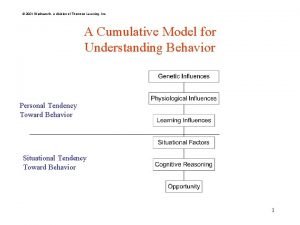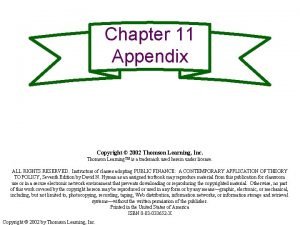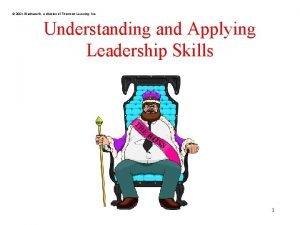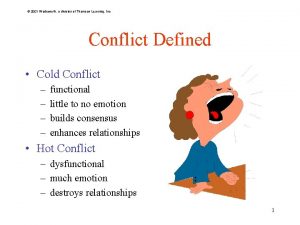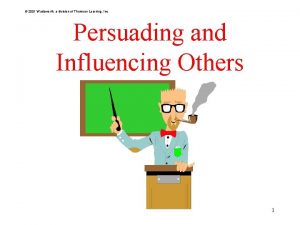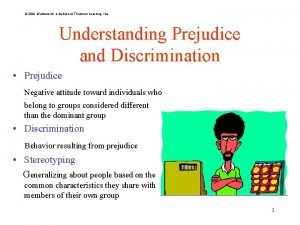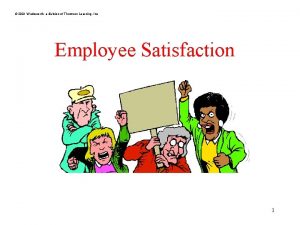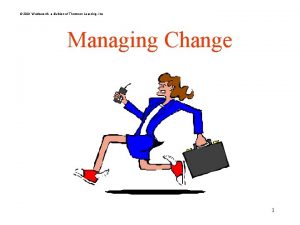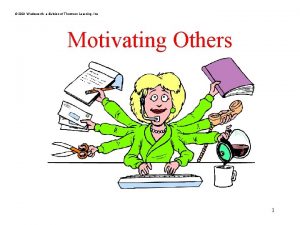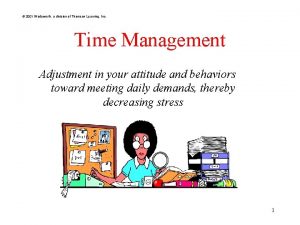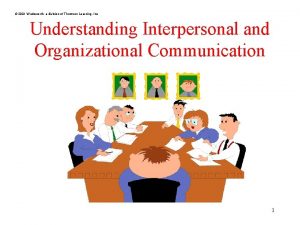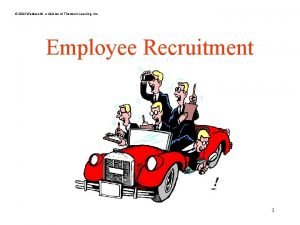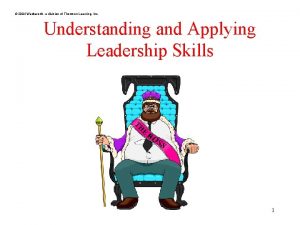2001 Wadsworth a division of Thomson Learning Inc


















- Slides: 18

© 2001 Wadsworth, a division of Thomson Learning, Inc A Cumulative Model for Understanding Behavior Personal Tendency Toward Behavior ___________________ Situational Tendency Toward Behavior 1

© 2001 Wadsworth, a division of Thomson Learning, Inc Genetics • • • 90% of height 70% of major depression 60% of intelligence 50% of smoking 40% of personality 40% of job satisfaction 50% of criminality 50% of aggression Many mental health problems 2

© 2001 Wadsworth, a division of Thomson Learning, Inc Physiological Influences • Head injuries and brain abnormalities • Neurotransmitters • Hormones • Arousal levels • Diet • Physical appearance • Illness and disability 3

© 2001 Wadsworth, a division of Thomson Learning, Inc • • Physical Appearance Infancy – attractive babies are held, cuddled, and kissed more Attractive Children – have more friends – are seen by teachers as being smarter – are disciplined less often Adolescence – attractive teens have more dates Attractive Adults – receive higher interview scores – receive higher performance appraisal scores – are sent to jail less often – are committed to mental health facilities less often – receive more help in emergencies 4

© 2001 Wadsworth, a division of Thomson Learning, Inc Physical Attractiveness and Crime • Masters and Graves (1967) – 60% of criminals have facial defects – 20% of controls • Thompson (1990) – Reviewed 9 studies and found that in 6, recidivism decreased after plastic surgery 5

© 2001 Wadsworth, a division of Thomson Learning, Inc Learning History • Types of Learning – Social learning – Operant conditioning • We Learn – – – Consequences How to be reinforced Anger and resentment Social needs and skills Attachment to the community Coping skills 6

© 2001 Wadsworth, a division of Thomson Learning, Inc Learning Influences • • Developmental era Where we were raised Family Friends School and church Gender, race, and culture Significant emotional events 7

© 2001 Wadsworth, a division of Thomson Learning, Inc Developmental Era 8

© 2001 Wadsworth, a division of Thomson Learning, Inc Urban vs. Rural Background Difference Crime Traffic Pace of life Crowding Variety of entertainment Variety of cultures High school sports Result Lack of trust Patience Energy Stress, friendliness Urbanity Sensitivity Competitiveness 9

© 2001 Wadsworth, a division of Thomson Learning, Inc Birth Order • Only child – higher intelligence – more independent • First born – achievement oriented – conservative • Middle born – outgoing – good social skills • Youngest – creative – rebels 10

© 2001 Wadsworth, a division of Thomson Learning, Inc Demographics • • • Gender Race National origin Religion Disability Age 11

© 2001 Wadsworth, a division of Thomson Learning, Inc Television and the Media • • • We watch five hours of TV per day 8 of 10 shows contain violence Cartoons have 18 acts of violence per hour Romance and sex Exposure to tragedy 12

© 2001 Wadsworth, a division of Thomson Learning, Inc When is Our Personality Set? • • • Birth Freud Massey Never Significant emotional events 13

© 2001 Wadsworth, a division of Thomson Learning, Inc Situational Factors • Environmental stress – frustration – heat, noise, darkness, crowding • Behavior of others • Time and resource limitations • Competing values • Availability of alternatives 14

© 2001 Wadsworth, a division of Thomson Learning, Inc Cognitive Reasoning • Expectancy theory – Expectancy – Instrumentality – Valence • Reasoning is affected by – Alcohol and drugs – Anger – Stress – Emotion – Intelligence – Knowledge/experience 15

© 2001 Wadsworth, a division of Thomson Learning, Inc Opportunity 16

© 2001 Wadsworth, a division of Thomson Learning, Inc Personality Characteristics 17

© 2001 Wadsworth, a division of Thomson Learning, Inc Communication Styles 18
 Wadsworth thomson learning
Wadsworth thomson learning Wadsworth/thomson learning
Wadsworth/thomson learning Thomson wadsworth
Thomson wadsworth Thomson learning inc
Thomson learning inc Thomson wadsworth
Thomson wadsworth Thomson wadsworth
Thomson wadsworth Thomson learning inc
Thomson learning inc Thomson learning inc
Thomson learning inc Wadsworth cengage learning
Wadsworth cengage learning Coglab.wadsworth
Coglab.wadsworth Henry wadsworth longfellow short biography
Henry wadsworth longfellow short biography Hn wadsworth
Hn wadsworth Neural tube defect
Neural tube defect Thomson delmar learning
Thomson delmar learning Where is protein digested
Where is protein digested Cuadro comparativo de e-learning b-learning y m-learning
Cuadro comparativo de e-learning b-learning y m-learning Long division and short division
Long division and short division Synthetic devision
Synthetic devision Method of hcf
Method of hcf


